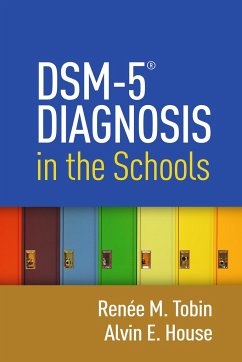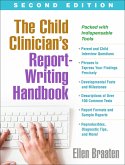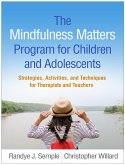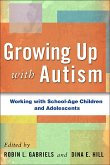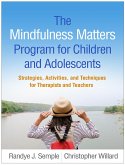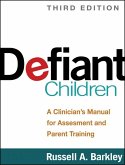Schade – dieser Artikel ist leider ausverkauft. Sobald wir wissen, ob und wann der Artikel wieder verfügbar ist, informieren wir Sie an dieser Stelle.
- Broschiertes Buch
- Merkliste
- Auf die Merkliste
- Bewerten Bewerten
- Teilen
- Produkt teilen
- Produkterinnerung
- Produkterinnerung
This key resource helps practitioners optimize their diagnostic practices in PreK-12 settings. Now significantly revised for DSM-5, the book cuts through the overwhelming length and complexity of the diagnostic manual by focusing thematically on the most common child and adolescent concerns.
Andere Kunden interessierten sich auch für
![Executive Function Skills in the Classroom Executive Function Skills in the Classroom]() Laurie FaithExecutive Function Skills in the Classroom60,99 €
Laurie FaithExecutive Function Skills in the Classroom60,99 €![The Child Clinician's Report-Writing Handbook The Child Clinician's Report-Writing Handbook]() Ellen Braaten (Massachusetts General Hospital / Harvard Medical SchooThe Child Clinician's Report-Writing Handbook69,99 €
Ellen Braaten (Massachusetts General Hospital / Harvard Medical SchooThe Child Clinician's Report-Writing Handbook69,99 €![The Mindfulness Matters Program for Children and Adolescents The Mindfulness Matters Program for Children and Adolescents]() Randye J SempleThe Mindfulness Matters Program for Children and Adolescents62,99 €
Randye J SempleThe Mindfulness Matters Program for Children and Adolescents62,99 €![Growing Up with Autism Growing Up with Autism]() Growing Up with Autism43,99 €
Growing Up with Autism43,99 €![The Mindfulness Matters Program for Children and Adolescents The Mindfulness Matters Program for Children and Adolescents]() Randye J. Semple (United States University of Southern California)The Mindfulness Matters Program for Children and Adolescents52,99 €
Randye J. Semple (United States University of Southern California)The Mindfulness Matters Program for Children and Adolescents52,99 €![The Construction of the Self The Construction of the Self]() Susan Harter (United States University of Denver)The Construction of the Self58,99 €
Susan Harter (United States University of Denver)The Construction of the Self58,99 €![Defiant Children Defiant Children]() Russell A. Barkley (Virginia Commonwealth University School of MediDefiant Children58,99 €
Russell A. Barkley (Virginia Commonwealth University School of MediDefiant Children58,99 €-
-
This key resource helps practitioners optimize their diagnostic practices in PreK-12 settings. Now significantly revised for DSM-5, the book cuts through the overwhelming length and complexity of the diagnostic manual by focusing thematically on the most common child and adolescent concerns.
Produktdetails
- Produktdetails
- Verlag: Guilford Publications
- Seitenzahl: 268
- Erscheinungstermin: 13. Februar 2020
- Englisch
- Abmessung: 226mm x 152mm x 20mm
- Gewicht: 386g
- ISBN-13: 9781462543748
- ISBN-10: 146254374X
- Artikelnr.: 58356224
- Herstellerkennzeichnung
- Libri GmbH
- Europaallee 1
- 36244 Bad Hersfeld
- gpsr@libri.de
- Verlag: Guilford Publications
- Seitenzahl: 268
- Erscheinungstermin: 13. Februar 2020
- Englisch
- Abmessung: 226mm x 152mm x 20mm
- Gewicht: 386g
- ISBN-13: 9781462543748
- ISBN-10: 146254374X
- Artikelnr.: 58356224
- Herstellerkennzeichnung
- Libri GmbH
- Europaallee 1
- 36244 Bad Hersfeld
- gpsr@libri.de
Renée M. Tobin, PhD, is Professor and Chair of the Department of Psychological Studies in Education at Temple University. She teaches graduate-level courses in social, emotional, and behavioral assessment; theories of counseling; consultation; and counseling techniques. She also supervises interns and advanced doctoral students providing assessment, consultation, and therapy for children and adolescents in school, clinic, and residential placement settings. Her primary research publications examine personality and social development, with a focus on promoting emotion regulation processes in youth. Alvin E. House, PhD, is Professor Emeritus in the Department of Psychology at Illinois State University. His professional practice and research focus on applying assessment results in school, vocational, medical, and forensic consultations. He is the author of The First Session with Children and Adolescents and coauthor of a manual on observational assessment of children, as well as journal articles and book chapters on intellectual, personality, and neuropsychological testing.
1. Introduction: Purposes and Features of This Book
I. Diagnostic Issues and the Use of DSM-5
2. Psychiatric Diagnosis: Issues for School Psychologists
3. An Overview of the DSM-5 Diagnostic System
4. Learning to Use DSM-5
II. Guidelines for Evaluation of Presenting Problems
5. Problems with Intellectual Ability and Cognition
6. Learning, Communication, and Motor Problems
7. Highly Atypical Symptom Patterns: Autism Spectrum Disorders and
Psychoses
8. Mood Problems
9. Anxiety Problems
10. Other Internalizing Problems
11. Problems with Conduct
12. Problems with Impulse Control
13. Highly Focused Symptom Patterns
14. Substance-Related Problems and Other Addictive Behaviors
15. Personality Disorders
16. Additional Codes and Categories
III. The Application of DSM-5 In School Settings: Issues and Topics
17. Ethics and Professional Responsibility in Evaluation
18. The Case Record: Data and Supporting Documentation for Diagnosis
19. Seeking Reimbursement for Assessment and Diagnosis within School
Settings
20. DSM-5 and the Individuals with Disabilities Education Improvement Act
21. Concerns about DSM-5
I. Diagnostic Issues and the Use of DSM-5
2. Psychiatric Diagnosis: Issues for School Psychologists
3. An Overview of the DSM-5 Diagnostic System
4. Learning to Use DSM-5
II. Guidelines for Evaluation of Presenting Problems
5. Problems with Intellectual Ability and Cognition
6. Learning, Communication, and Motor Problems
7. Highly Atypical Symptom Patterns: Autism Spectrum Disorders and
Psychoses
8. Mood Problems
9. Anxiety Problems
10. Other Internalizing Problems
11. Problems with Conduct
12. Problems with Impulse Control
13. Highly Focused Symptom Patterns
14. Substance-Related Problems and Other Addictive Behaviors
15. Personality Disorders
16. Additional Codes and Categories
III. The Application of DSM-5 In School Settings: Issues and Topics
17. Ethics and Professional Responsibility in Evaluation
18. The Case Record: Data and Supporting Documentation for Diagnosis
19. Seeking Reimbursement for Assessment and Diagnosis within School
Settings
20. DSM-5 and the Individuals with Disabilities Education Improvement Act
21. Concerns about DSM-5
1. Introduction: Purposes and Features of This Book
I. Diagnostic Issues and the Use of DSM-5
2. Psychiatric Diagnosis: Issues for School Psychologists
3. An Overview of the DSM-5 Diagnostic System
4. Learning to Use DSM-5
II. Guidelines for Evaluation of Presenting Problems
5. Problems with Intellectual Ability and Cognition
6. Learning, Communication, and Motor Problems
7. Highly Atypical Symptom Patterns: Autism Spectrum Disorders and
Psychoses
8. Mood Problems
9. Anxiety Problems
10. Other Internalizing Problems
11. Problems with Conduct
12. Problems with Impulse Control
13. Highly Focused Symptom Patterns
14. Substance-Related Problems and Other Addictive Behaviors
15. Personality Disorders
16. Additional Codes and Categories
III. The Application of DSM-5 In School Settings: Issues and Topics
17. Ethics and Professional Responsibility in Evaluation
18. The Case Record: Data and Supporting Documentation for Diagnosis
19. Seeking Reimbursement for Assessment and Diagnosis within School
Settings
20. DSM-5 and the Individuals with Disabilities Education Improvement Act
21. Concerns about DSM-5
I. Diagnostic Issues and the Use of DSM-5
2. Psychiatric Diagnosis: Issues for School Psychologists
3. An Overview of the DSM-5 Diagnostic System
4. Learning to Use DSM-5
II. Guidelines for Evaluation of Presenting Problems
5. Problems with Intellectual Ability and Cognition
6. Learning, Communication, and Motor Problems
7. Highly Atypical Symptom Patterns: Autism Spectrum Disorders and
Psychoses
8. Mood Problems
9. Anxiety Problems
10. Other Internalizing Problems
11. Problems with Conduct
12. Problems with Impulse Control
13. Highly Focused Symptom Patterns
14. Substance-Related Problems and Other Addictive Behaviors
15. Personality Disorders
16. Additional Codes and Categories
III. The Application of DSM-5 In School Settings: Issues and Topics
17. Ethics and Professional Responsibility in Evaluation
18. The Case Record: Data and Supporting Documentation for Diagnosis
19. Seeking Reimbursement for Assessment and Diagnosis within School
Settings
20. DSM-5 and the Individuals with Disabilities Education Improvement Act
21. Concerns about DSM-5

